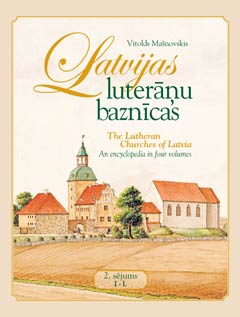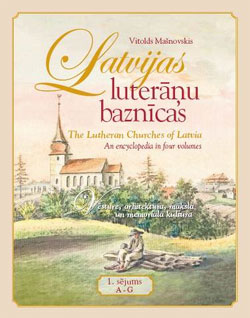
A year ago, after the publication of the first volume of The Lutheran Churches of Latvia (Latvijas luterāņu baznīcas), the literary critic Pēteris Bankovskis wrote, “Only a pure enthusiast has enough energy for such grand works in such an adverse environment.”
Many people have felt the urge to photograph, document and compile Latvia’s cultural and historical heritage, but it is no secret that many of these efforts still lie in the drawers of their authors’ desks because it is nearly impossible to find a publisher. Vitolds Mašnovskis, though, has been lucky—the second volume of his encyclopedia has just been published, and only a year after the publication of the first volume.
Mašnovskis found a willing partner in Inta Bērente-Strenga, the director of the creative design agency DUE, who had the faith to even invest her personal finances in order to publish the encyclopedia. At the recent opening celebration for the second volume she stressed the great efforts of Mašnovskis and explained: “We became involved in this project four years ago, because we viewed this as a one-of-a-kind opportunity to take part in the creation of this voluminous reference material. It is a unique piece of work. I am convinced that another such grand research project about this topic will not be repeated any time soon.”
Mašnovskis spent more than 13 years gathering and compiling information for The Lutheran Churches of Latvia. He drove countless times from one end of Latvia to the other and spent hours and hours of his free time photographing each church and finding and reading historical documents in archives and museums. The encyclopedia is aimed at a wide audience, and it is the first publication that reflects upon the history, architecture and artwork of all 337 former and current Lutheran churches in the country. The first two volumes cover churches beginning with the letters A through L—from Abrene to Lutriņi.
Like the first volume, the second volume also contains beautiful color pictures of every church, highlighting masterpieces such as the elaborate Rococo style furnishings in the Liepāja Sv. Trīsvienības church. The author has painstakingly described the history of each church in great detail, much of which is usually connected to the German barons and their estates. The books therefore also include illustrations of German coats of arms. The encyclopedia contains many interesting, forgotten and little-known facts. For example, the graphic artist Sigismunds Vidbergs (who emigrated to the United States and was later known for the erotic themes in his artwork) drew the sketches for the stained glass windows in the Lielstraupe church.
The encyclopedia describes the harsh treatment of churches during the Soviet occupation of Latvia following World War II. For example, in 1949 local kolkhoz directors, led by visions of collectivization and atheistic propaganda, transformed the Allaži church into a cafeteria for a neurological hospital; later it was used as a warehouse. After the war, the Ādaži church was often vandalized, until in 1972 it finally became a warehouse for empty bottles and containers. The Garkalne church endured a similar fate, although surprisingly the painting “The Last Supper” by Johann Maddaus was spared. Unfortunately, no one knows the fate of the painting “Christ Blesses the Fields” by well-known artist Augusts Annuss, which was dedicated in the Allaži church in 1942.
The Lutheran Churches of Latvia is truly a comprehensive publication, and the English language summaries also allow non-Latvian readers to gain insight into the histories and architecture of Latvia’s many churches. The encyclopedia has become one of the most often requested books in Latvian libraries, and students use it as a source for school projects. Some readers have even begun to use pages copied from the encyclopedia as a tour guide when traveling around the country and familiarizing themselves with their cultural heritage.
Volume 2 of the encyclopedia contains 486 pages, 798 photographs and more than 140 schematic drawings and maps. All four volumes of the encyclopedia will contain a total of 4,000 photographs. At the opening celebration, Minister for Children and Family Affairs Ainārs Baštiks stressed that the encyclopedia’s thoroughness in the field of cultural history will help popularize Latvia’s image in the world. The art historian Ingrīda Burāne expressed her hope that the encyclopedia will become an heirloom for families to pass down from generation to generation.
Details
Latvijas luterāņu baznīcas, 2.sejums
Vitolds Mašnovskis
Rīga: DUE, 2006
ISBN 9984990699
Where to buy
Purchase Latvijas luterāņu baznīcas, 2.sejums from BalticShop.
Note: Latvians Online receives a commission on purchases.




